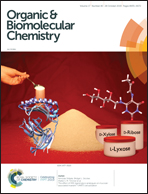The effect of MR1 ligand glyco-analogues on mucosal-associated invariant T (MAIT) cell activation†
Abstract
Mucosal-associated invariant T (MAIT) cells are a subset of recently identified innate-like T lymphocytes that appear to play an important role in many pathologies ranging from viral and bacterial infection, to autoimmune disorders and cancer. MAIT cells are activated via the presentation of ligands by MR1 on antigen presenting cells to the MAIT T cell receptor (TCR), however few studies have explored the effects of systematic changes to the ligand structure on MR1 binding and MAIT cell activation. Herein, we report on the first study into the effects of changes to the sugar motif in the known MAIT cell agonists 7-hydroxy-6-methyl-8-D-ribityllumazine (RL-6-Me-7-OH) and 5-(2-oxopropylideneamino)-6-D-ribitylaminouracil (5-OP-RU). Tetramer staining of MAIT cells revealed that the absence of the 2′-hydroxy group on the sugar backbone of lumazines improved MR1–MAIT TCR binding, which could be rationalised using computational docking studies. Although none of the lumazines activated MAIT cells, all 5-OP-RU analogues showed significant MAIT cell activation, with several analogues exhibiting comparable activity to 5-OP-RU. Docking studies with the 5-OP-RU analogues revealed different interactions between the sugar backbone and MR1 and the MAIT TCR compared to those observed for the lumazines and confirmed the importance of the 2′-hydroxy group for ligand binding and activity. Taken together, this information will assist in the development of future potent agonists and antagonists of MAIT cells.

- This article is part of the themed collection: Chemical Biology in OBC


 Please wait while we load your content...
Please wait while we load your content...